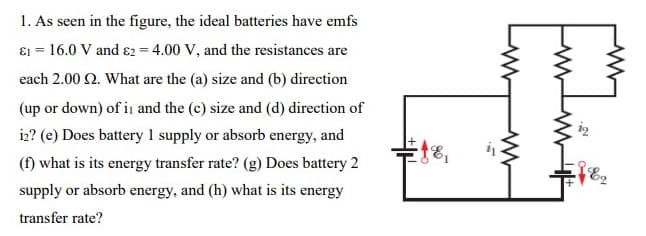1. As seen in the figure, the ideal batteries have emfs E1 = 16.0 V and ɛ2 = 4.00 V, and the resistances are each 2.00 2. What are the (a) size and (b) direction (up or down) of in and the (c) size and (d) direction of iz? (e) Does battery 1 supply or absorb energy, and (f) what is its energy transfer rate? (g) Does battery 2 supply or absorb energy, and (h) what is its energy transfer rate?
1. As seen in the figure, the ideal batteries have emfs E1 = 16.0 V and ɛ2 = 4.00 V, and the resistances are each 2.00 2. What are the (a) size and (b) direction (up or down) of in and the (c) size and (d) direction of iz? (e) Does battery 1 supply or absorb energy, and (f) what is its energy transfer rate? (g) Does battery 2 supply or absorb energy, and (h) what is its energy transfer rate?
Physics for Scientists and Engineers: Foundations and Connections
1st Edition
ISBN:9781133939146
Author:Katz, Debora M.
Publisher:Katz, Debora M.
Chapter29: Direct Current (dc) Circuits
Section: Chapter Questions
Problem 19PQ
Related questions
Question

Transcribed Image Text:1. As seen in the figure, the ideal batteries have emfs
ɛ1 = 16.0 V and ɛ2 = 4.00 V, and the resistances are
each 2.00 2. What are the (a) size and (b) direction
(up or down) of i and the (c) size and (d) direction of
iz? (e) Does battery 1 supply or absorb energy, and
(f) what is its energy transfer rate? (g) Does battery 2
supply or absorb energy, and (h) what is its energy
transfer rate?
Expert Solution
This question has been solved!
Explore an expertly crafted, step-by-step solution for a thorough understanding of key concepts.
Step by step
Solved in 2 steps with 2 images

Knowledge Booster
Learn more about
Need a deep-dive on the concept behind this application? Look no further. Learn more about this topic, physics and related others by exploring similar questions and additional content below.Recommended textbooks for you

Physics for Scientists and Engineers: Foundations…
Physics
ISBN:
9781133939146
Author:
Katz, Debora M.
Publisher:
Cengage Learning

Physics for Scientists and Engineers: Foundations…
Physics
ISBN:
9781133939146
Author:
Katz, Debora M.
Publisher:
Cengage Learning